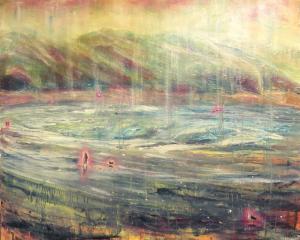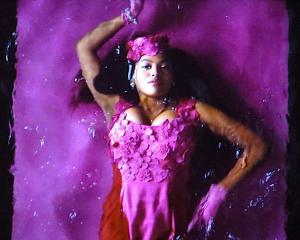In this week's Art Seen, James Dignan looks at exhibitions at Gallery DeNovo, Milford Gallery, and the Dunedin Public Art Gallery.

DeNovo's current exhibition pairs the strong impressionistic landscapes of Jennie de Groot and the eye-catching meditative glasswork of Di Tocker.
De Groot's paintings are strongly rooted in the rhythms of the Otago landscape. Landforms are often hinted at rather than directly stated in works where the palette captures and conveys the essence of the country. The paintings, created with brush and knife, are dynamic, and painted with vigour and confidence. The radiating strokes of Guided Home and Burnt Around the Edges produce visceral traces of the equally strong landscapes represented. Quieter pieces, such as the sombre Untethered, capture the spirit of the land equally effectively.
Against these strong backdrops, Di Tocker's small attractive glass forms gain a Zen-like meditative quality. Figures stand and sit enclosed in circles of colour, or adrift on spirit-boats on some unknown sea. Others are captured like bugs in amber within solid blocks of translucency. The crystalline forms glow in soft tones, the pellucid colours shift and blend as the light moves around them. There is an intense thoughtfulness about the figures which enables the viewer to feel a personal connection with them. They have a rough familiarity; clearly hewn, they seem to represent the lost soul hopefully travelling to an unknown destination.

Simon Clark's ``Hot Pools'' delves deep into the essence of what we consider to be New Zealand. It probes the myth-making of Kiwiana, the fantasies we have built up of a New Zealand where man-alone Pakeha and happy poi-twirling Maori live side by side in an egalitarian land of endless grandeur and natural wealth.
Using products of 1950s advertising as his basis, Clark has created a series of circular images which hold a mirror up to these happy stereotypes. We see the pounamu-skinned Maori doll and the grinning Frosty Boy arrayed against the iconic form of Mitre Peak, the ubiquitous day-away Morris 1000 in the faded light of old holiday snaps and, above all, nostalgic cliched slogans, all presented against the harsh but welcoming reflections of gold and silver leaf backgrounds. The works play with the boundaries between high art and low art; impeccably created, simultaneously amusing and thought-provoking, they nonetheless carry an evocation of kitsch. The designs deliberately mock the advertising poster and also resonate with thoughts of such low art classics as Tretchikoff's once ubiquitous Green Lady. As such, there is also a sense of suburban nostalgia about the pieces, enhanced by the rich artificiality of the colours.
The works are pointed in their message, but are also highly attractive, enjoyably humorous, and beautifully made.

Andrew Barber's ``Folly (Stone Carpet)'' makes use of the gallery space in an unexpected way. Whereas art might be expected to hang on the wall or be installed as free-standing objects, ``Folly'' is presented as a floor upon which gallery visitors can walk as they explore the work.
The installation reflects on the conflicting needs of utilitarianism and decorative art, conflict which causes heavy-duty surfaces such as paving to frequently be overlooked as sites for decoration. The need for a durable surface militates against art as a facing for flooring, yet Barber argues that this neglect is nonsense. Over the history of art, floors and floor coverings have often been artistically designed, from Roman mosaics through to Persian rugs and beyond. It is only relatively recently that the floor has become something for the tradesman rather than the fine artist. There is scope to reclaim the floor as a worthy location for design.
Barber, in his art, is often interested in pattern - two of Barber's works within the gallery's ``Loveliness Extreme'' exhibition examine the thick plaid often associated with Swanndri clothing. In ``Folly'', the artist creates sunbursts through the seemingly haphazard arrangement of mottled grey forms representing broken stone within a background matrix of ochre. The resulting work is attractive, and brings life to what would otherwise be a mundane floor.






![... we all become all of these things [installation view] (2025), by Megan Brady.](https://www.odt.co.nz/sites/default/files/styles/odt_landscape_small_related_stories/public/story/2025/03/1_we_all_become_all_of_thes.jpg?itok=SH-Q8KJZ)


![Poipoia te Kākano [installation view]. Allison Beck, Megan Brady, Kate Stevens West, Jess...](https://www.odt.co.nz/sites/default/files/styles/odt_landscape_small_related_stories/public/story/2025/02/1_poipoia_te_k_kano.jpg?itok=_BEDlada)


